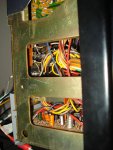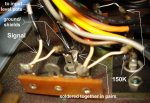I've started tracking ideas to my Teac A-3340S. I've noticed a little thing that I would like to remedy and would welcome some help on:
I have an intermittent noise issue. It sporadically appears in the output of all four channels, more obvious in "source" than in "tape" position, but if it's there, it's there either way and I can record it to tape and play it back. The proper signal is not interrupted, but it's the kind of buzzy, grounding issue sound you get from a cable hooked into an amp input but not plugged into a source. If it's not making the sound, it can be induced by a few "pro audio whacks" on the back panel or front panel, and then can be temporarily knocked off again by another few whacks. If it's recording quietly and I hit the transport to stop and rewind, it may pop back on, and if it's making the sound when the transport is stopped, starting the machine into play mode may stop it. I really noticed it most (as in the largest transient at the time of the whack) when tapping the back panel where the audio go in and out and the power and ground lug are located.
Given that the machine has RCA outputs and the ground part of the RCA jacks relies on contact with that back plate and presumably some grounding scheme from that point to other key points in the machine, I'm assuming there is some kind of intermittent ground contact within the unit. Any thoughts as to the most likely culprits? Something in the power connection? The RCA jacks themselves? I've also noticed I can induce the noise (and then abate it) by removing or driving in screws that hold the lower and back panels in place or other screws holding the exterior frame pieces together.
Helpful suggestions are welcome!
Cheers,
Otto
I have an intermittent noise issue. It sporadically appears in the output of all four channels, more obvious in "source" than in "tape" position, but if it's there, it's there either way and I can record it to tape and play it back. The proper signal is not interrupted, but it's the kind of buzzy, grounding issue sound you get from a cable hooked into an amp input but not plugged into a source. If it's not making the sound, it can be induced by a few "pro audio whacks" on the back panel or front panel, and then can be temporarily knocked off again by another few whacks. If it's recording quietly and I hit the transport to stop and rewind, it may pop back on, and if it's making the sound when the transport is stopped, starting the machine into play mode may stop it. I really noticed it most (as in the largest transient at the time of the whack) when tapping the back panel where the audio go in and out and the power and ground lug are located.
Given that the machine has RCA outputs and the ground part of the RCA jacks relies on contact with that back plate and presumably some grounding scheme from that point to other key points in the machine, I'm assuming there is some kind of intermittent ground contact within the unit. Any thoughts as to the most likely culprits? Something in the power connection? The RCA jacks themselves? I've also noticed I can induce the noise (and then abate it) by removing or driving in screws that hold the lower and back panels in place or other screws holding the exterior frame pieces together.
Helpful suggestions are welcome!
Cheers,
Otto





 ), check physical conditions there, connections etc
), check physical conditions there, connections etc



